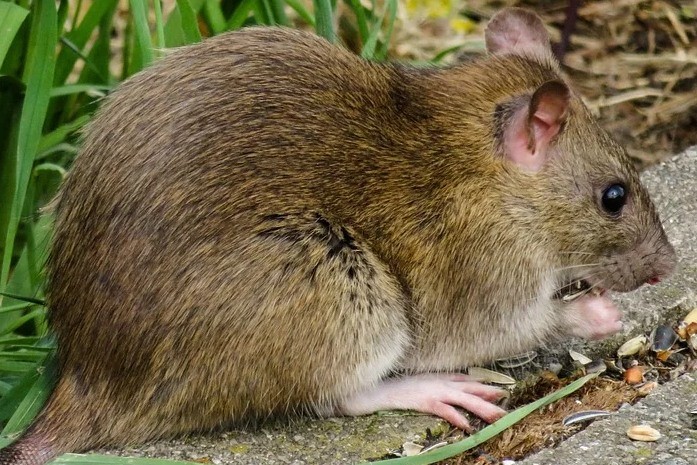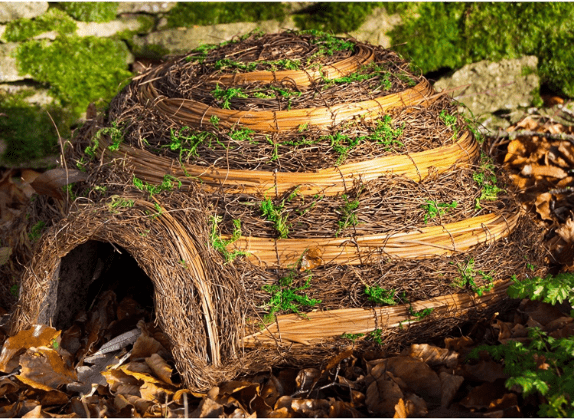Given that rats build nests under houses, burrow beneath walls, and take shelter amongst shrubs, there is a good possibility that rats would live in a hedgehog house. This possibility only increases with the presence of food and water – and if the house is in an area that attracts rats.
A personal concern of mine is that if I set up a hedgehog house, I will get more than I bargained for. That is, I will see different animals other than hedgehogs take advantage of the shelter I have provided for my spiny friends.
This is especially the case with animals like rats, whose adaptability and appetite make for quite some competition for hedgehogs, let alone being considered a disease-carrying pest. The last thing you want to see is a nest of rats, or rat droppings inside a hedgehog house.
So I’ve always wondered: Will rats live in a hedgehog house? This question is asked quite a bit by newcomers setting up hedgehog houses — and with good cause. From what I’ve researched about rats, and seen with my own eyes, I would say there’s reason to believe they would. Let’s take a look.
Introduction: The Rat
There are two species of rat in the UK. These include the Brown or Common Rat (RATTUS NORVEGICUS) and the Black Rat (RATTUS RATTUS). Both species are considered not native to the British Isles, although they have been around here for thousands of years.

Though the black rat was once more common, its range today is relatively limited — and quickly disappearing from old port cities. The brown rat, however, is a much wider-spread animal, and both are considered pests.
Both species are nocturnal animals that feed during the night. They also have fairly rapacious appetites for their size (the black rat being 12 to 18 cm, weighing 75 to 230 grams, and the brown rat being 15 to 28 cm long and weighing 140 to 500 grams), and can eat up to 50 grams of food a day.
During the day, rats like to sleep in their burrows or nests. They are likely to be most active in the periods roughly 30 minutes before dawn and 30 minutes after sundown. Rats usually forage in areas about 100 to 300 feet away from their nests each night.
Both species of rats tend to build their nests in or near places that are warm and have plenty of nearby food. As far as brown rats are concerned, they will build their nests in sewers, under roofs, right beneath house walls, under floorboards, under sheds, or in places of high brush, log, or leaf cover.
Although their preferred food is grain, rats are impartial eaters. They will eat almost anything: vegetables, nuts, meat, seeds, milk, candy, leather, fur, dog feces, pet foods, poultry, fruit, carrion, eggs, soap, bird seed, garbage, grass seeds, spoiled foods, compost foods, and fresh human foods.
Rats are also burrowing animals that can make extensive tunneling systems. The brown rat will start to burrow next to/under the wall areas of a house or shed and continue to make a series of multiple-leveled tunnels with a second entrance.
Finally, although rats are territorial creatures, they do nest in large groups (especially a rat mother with her offspring) and will huddle together for warmth. Provided that their nest provides them adequate cover and is near a steady source of food and water, rats will reproduce and live there.
Hedgehog Houses
Hedgehog houses are human-made shelters specifically designed for hedgehogs. They have gained popularity in recent years as a concerted effort has been made to increase the declining hedgehog population here in the UK.
Hedgehog houses may be of the home-built or the store-bought kind, but their common features include a hole/tunnel large enough for a hedgehog to enter (some 13 cm long by 13 cm wide) and the main living room large enough for the hedgehog to create a nest (some 1050 square cm or so).
These houses may be lined with dry leaves, straw, or grass for the purpose of creating a nesting environment close to what hedgehogs would create in the wild. The houses are usually placed on the ground amongst shrubs or hedges, or even with their entrances facing fences.
Some people place dishes of food and/or water inside their hedgehog houses, or right beside them. In this case, the idea is to keep an on-hand source of food available for the hedgehog during times of scarcity — especially during the winter months when it is likely hibernating.
This may seem like a good idea for the hedgehogs, but if you know anything about rats, a well-stocked, comfortable hedgehog house also makes an inviting residence for these rodents. Hopefully, the reasons described below will dispel any bad practices.
Why Rats Would Live Inside A Hedgehog House
So knowing what we know about rats, and what we know about hedgehog houses, the question remains: will rats live in a hedgehog house? The short answer is yes, but the likelihood that they do increases with an existing rat population, and available food, water, and shelter. Here’s why.
They Are Already In the Area
If rats are already in your neighborhood, there is a higher chance that they will inhabit a hedgehog house. A neighborhood can have a large rat population if garbage is not kept in secure cans, or if there is a pet or human food available in nearly any quantity outside.
Rats are omnivorous creatures with an uncanny ability to seek out food, even in hard-to-reach places. Some rats can fit into holes as small as 0.6 centimeters in diameter, or climb easily under sheds or over garden walls.
Any food that is present in these outside-adjacent areas is subject to scrutiny (and eating) by these rodents. Even animal (especially dog) feces are not safe from a rat population, they are simply not that picky about what they eat.
In order to lessen the possibility of a rat outbreak in your neighborhood, make sure you keep a clean backyard or garden. Never leave food outside in anything else but rodent-proof metal or glass containers. Clean up after your pets/their food, and keep your gardens tidy of unharvested vegetables.
Clean your barbecue grills thoroughly and keep your yard free of unmanageable leaves, grass, rock, or log piles. Clean your grass and hedge trimmings up, and do not leave bags of garbage around. If you have a birdfeeder, use one that is squirrel and rat-proof, and clean up around it.
Make sure that you dispose of garbage in rat-proof cans — and do not keep compost in anything other than hard, rodent-proof containers. Talk with your neighbors about rat prevention techniques — chances are they want a rat-free neighborhood too!
Food
It should be clear by now that rats will be attracted to any food, even that within a hedgehog house. Besides being fed, they have a place to nest — and this makes it that much easier for rats to live and reproduce there.
Never put food inside a hedgehog house, or even leave food outside next to the house unattended. If you want to feed a hedgehog, make sure you know you already have one inside your hedgehog house.
At this point, you can choose to put a shallow dish of food (and water) out in an open part of your yard late at night — and wait for the hedgehog to approach. This will feed the hedgehog in off-peak rat waking hours, and you can keep an eye on the food as the hedgehog eats.
Once the hedgehog has finished, pick the food and water dishes back up — and look carefully for any dropped food. Hose down or clean your dishes in a place that will not accumulate excess food. Remember to store all hedgehog foodstuffs in secure containers.
If you aren’t keen on feeding hedgehogs yourself, grow a hedgehog-friendly garden with flowers and plants that can provide a haven for beetles, earthworms, caterpillars, and pill millipedes — a hedgehog’s natural food supply.
Water
I used to think that having a dish of water out for hedgehogs wouldn’t do much harm when it came to rats — but it turns out rats wouldn’t mind having a drink either. Rats are water-dependent and need to drink up to an ounce a day.
It might be best to deliver water in the same way you would do hedgehog food — that is, in a shallow dish late into the night with supervision. This way, any neighborhood rats won’t have a chance to drink at all.
Shelter
A hedgehog house placed in a rat-friendly ground location will likely attract the rodents, for their immediate need of shelter. So it is best to keep hedgehog houses in a comfortable, yet manageable place — one visible from a window, perhaps — that can be cleaned relatively easily, if necessary.
A hedgehog house will need to be cleaned in April after the hibernation season, but before the hedgehogs give birth to hoglets, and in October, before the hibernation period begins. Doing so will remove any parasites, droppings, or organic matter — keeping it clean from rats and disease.
Conclusion
So, will rats live in hedgehog houses? The answer isn’t too complicated. If there are enough rats around, and enough reasons (like food and water) for them to be around, they will take shelter in a hedgehog house — or any place they find to provide them enough shelter.
Because of what I know now, I have taken some steps to make my yard a lot less rat-friendly. I have tidied up the areas where I used to keep excess leaves, and I have definitely kept my food away from the outdoors as much as I can. I can no longer leave water or food outside, knowing how rats are.
As far as my hedgehog house goes, I keep it in a place visible to me, but still comfortable enough for my spiny guests. Seeing them waddle in and out from time to time makes me glad I’ve tailored my backyard environment for just enough for hedgehogs — and not for rats.

